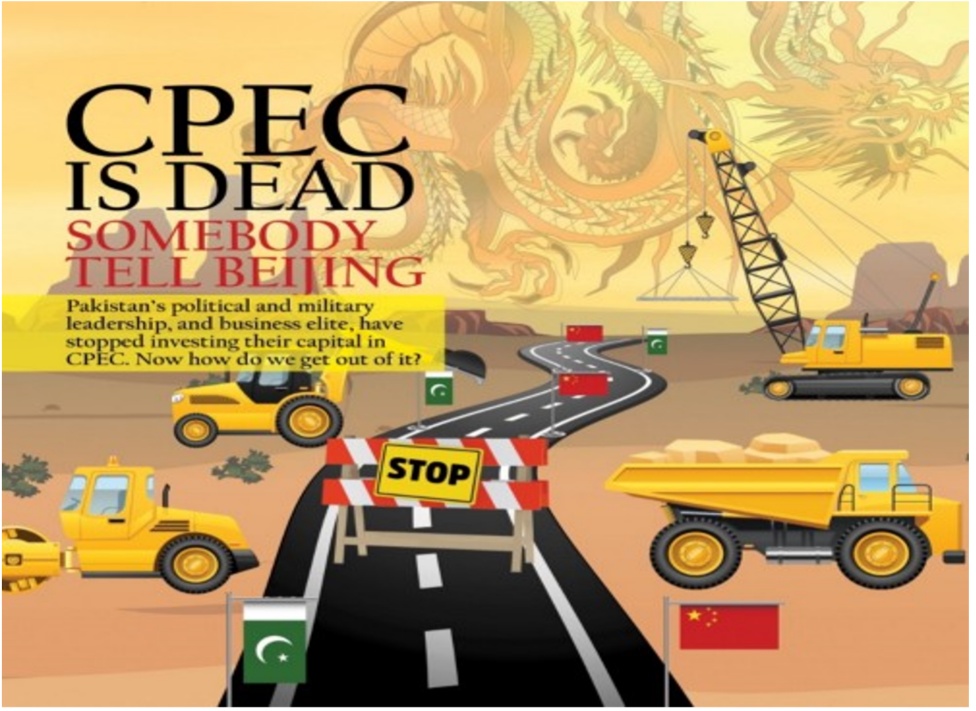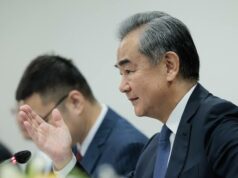CHINA PAKISTAN ECONOMIC CORRIDOR Is Dead- Beijing Must Be Told

BY
Farooq Tirmizi
It’s over. If ever there was a thought within Pakistan’s leadership — political, military, and business — that Beijing could replace Washington as the foreign capital with the most influence in Islamabad, that idea is now firmly dead. We just have not gotten around to telling China yet.
Over the past few weeks, this scribe has spoken to several sources in both Pakistan’s business elite circles as well as people who are familiar with the thought process of the military leadership and the picture emerging is not a favourable one of the relationship with China: the more Pakistanis learn about the true costs of the China Pakistan Economic Corridor (CPEC), the less inclined they are to want to participate any further than we already have.
If anything, the signal coming from the country’s establishment appears to be that, far from pivoting Pakistan’s economic and political orientation towards China, Pakistan should retain its historical role as the country that is able to balance its relationship with both China and the United States.
This emerging consensus — particularly within the military leadership — represents a subtle but important shift in the relationship with Beijing. Pakistan stared long and hard at the costs and benefits of becoming an integral part of what Beijing hopes will become the new Pax Sinica world order, and found it wanting. For all its flaws, Pax Americana still offers Pakistan a good deal. Nobody in Pakistan’s leadership wants to offend China, but nobody wants to bend over backwards to become a Chinese satellite state either.
Why CPEC is a raw deal
The biggest difference between the Pax Sinica and Pax Americana is one of how each superpower defines its own self-interest. The United States, though far from perfect, has a somewhat more enlightened view of the world order and America’s place in it: at least until the advent of President Donald Trump, the United States wanted to create a world order which is designed to benefit both the United States and its allies.
China it seems, by contrast, wants to build a world order where China’s needs are met first and foremost, and the rest of the world’s needs — including those of its allies — are at best secondary considerations, and at worst, not even considerations at all.
We will explain why we think this difference exists, and how it impacts Pakistan, but first, it is important to recognise why it may have developed in the first place.
The United States started becoming a powerful country in the 1890s as its wealth grew, but in the early years, the US did not make the effort to translate that wealth into significant military power, though it developed increasingly sophisticated military capabilities over the next 50 years.
By the end of World War II, however, the United States was not just the richest country in the world, it was richer than the rest of the world combined. (Seriously, for over 10 years following the war, the United States accounted for over half of global GDP.) It was also, despite some threats from the Soviet Union, more powerful militarily than the rest of the world.
It was in that heady moment of near absolute power that the United States stumbled into having to create Pax Americana, never having fully wanted a globally dominant role, and never having historically seen itself as the arbiter and guarantor of global peace and stability. That absolute power gave America a confidence that is unrivaled in history, and the accidental nature of its arrival in power allowed it to be generous with those who were losing it.
As a result, the system that the United States designed — the Bretton Woods institutional order, the Marshall Plan, etc. — were all designed to enable mutually beneficial relationships between Washington and its allies. America was unquestionably the leader, but it was a confident leader that did not feel the need to thump its chest and point out that it was the leader.
China, by contrast, is arriving at its Great Power status in a very different set of circumstances. We tend to speak of the ‘rise’ of China, but the truth is that for most of human history, China has been the richest and most powerful country on earth.
The past three hundred years where this has not been the case are actually a historical anomaly, and, from the Chinese perspective, an embarrassing interregnum from which they must recover.
In other words, China is not merely stumbling into Great Power status: it wants it, it believes it deserves it, and it will brook no opposition to getting what it wants.
The system that China has designed, therefore, is geared towards a completely different goal: unlike the United States, which was comfortable sharing its wealth and power as a means of growing wealth for both itself and its allies, China wants to create a global system where wealth and power flow in the direction of China as a means of strengthening it relative to its main rival (the United States), even if that means weakening its allies in the process.
This latter system has obvious flaws from the perspective of Pakistan, which has seen itself as one of modern China’s oldest and staunchest allies. The deal that Islamabad is getting from Beijing in the form of CPEC looks impressive from a distance, but is in fact far from a mutually beneficial relationship. CPEC makes British colonialism in South Asia look generous by comparison.
The flaws in CPEC
The biggest so-called mystery about CPEC is as follows: if CPEC was supposed to be such a huge bonanza for Pakistan in terms of investment, which is it not showing up in the foreign direct investment (FDI) numbers?
Why is Pakistan’s current account balance still negative? In fact, why is Pakistan’s current account balance actually getting worse?
The answer is relatively straightforward: because CPEC is not an investment into Pakistan, it is structured as a resource extraction exercise. Here is how it works: China announces that it has invested in a project in Pakistan worth, let’s say $1 billion. That $1 billion, however, is required to mostly be spent on Chinese equipment, and labour, a significant portion of which is to be imported from China as well, with very little by way of supplies coming from the local economy.
That $1 billion, therefore, never hits Pakistan’s economy as an investment. It is $1 billion that goes from the Chinese government or state-owned company to a state-owned company within China to pay for equipment. Even the Chinese labour gets its salaries deposited into bank accounts within China. The money, in other words, stays completely within China and so never shows up as foreign investment into Pakistan.
Where it does show up is in the trade statistics: that $1 billion of equipment will show up as an import, against which Pakistan will have to arrange foreign currency from somewhere. And it will show up as a liability on the balance sheets of whichever company or government entity is contracting with the Chinese government or state-owned company.
Let us recap what we get and what China gets out of this so-called $1 billion investment.
China gets:
· $1 billion in sales for a Chinese state-owned company
· $1 billion in new loans for a Chinese state-owned bank at very high interest rates
Pakistan gets:
· $0 in investment
· $1 billion in imports and increase in net trade deficit
· $1 billion in liabilities for a Pakistani company or government entity
As is evident from the above, this is an arrangement designed purely to benefit one party and that party is not Pakistan. It could still work out in Pakistan’s favour if the economic value of the asset being built was greater than the $1 billion in liabilities taken on to build it.
Unfortunately, more often than not, it is far from clear as to whether that is the case.
This example cited above, by the way, is not hypothetical. It is actually showing up in Pakistan’s macroeconomic numbers.
Pakistan’s imports from China have dramatically increased since 2013, when CPEC was first announced. Prior to 2013, Pakistan’s imports from China had been rising because of the 2007 China-Pakistan Free Trade Agreement, but had stabilized to around $6.6 billion a year. After 2013, the rise has been very steep.
We estimated how much of that is CPEC-related by assuming that the pre-2013 levels of imports from China can be categorized as the “normal” level and the amounts above that are broadly CPEC-related. By our calculations, using data from the Pakistan Bureau of Statistics, we estimate that Pakistan’s CPEC-related imports have come to $31 billion over the past six years.
Does that number sound familiar? It is very close to the number that was originally touted as the total economic value of CPEC’s “fast-track” projects. The government of China was not lying when they said CPEC would be worth that much. They just left out to whom.
The actual investment flows from China during that time have been higher than in the past, it is true, but still relatively smaller compared to this other method. Since 2013, China’s net investment into Pakistan has been $2.5 billion, much higher than the $813 million China invested in Pakistan in the 10 years prior to 2013, but still a relatively small sum compared to the wild projections and promises that the Pakistani press and government wanted to believe when it was first announced.
The shift in Pakistani thinking
While Pakistan’s civilian and military leadership is prone to making bad decisions, they are not completely stupid. They can see these numbers, and they are privy to far more details than have been told to the public about the specific terms of the agreements with China for CPEC projects. And it is becoming increasingly clear that they are becoming deeply uncomfortable with the direction this has taken Pakistan.
Neither the civilian politicians nor the military leadership want to accept the blame for what is clearly a massive blunder on the part of the government of Pakistan in negotiating the CPEC contracts. If any lawyers reviewed them, it is unclear if they understood them, or if their views were taken into consideration at all by the decision-makers. (Hint: there is a reason why good lawyers in the United States are rich: American businesses are willing to pay big money to them to help avoid precisely this kind of massive blunder. It is an investment well worth it.)
The deed is done now, however, and Pakistan cannot easily extricate itself from these arrangements. But, sources familiar with the military leadership’s thinking tell this scribe, the leadership in the military has decided to start following the first rule of being in a hole: stop digging.
A public renunciation of CPEC would be too embarrassing for the government — both the politicians and the Army — but they are certainly not willing to undertake any further agreements with the government of China.
According to one source, one factor that helped influence the military leadership came when even the military-owned FWO was subjected to exploitative lending contracts by Chinese state-owned companies for construction of CPEC infrastructure projects. It may not be worth risking the relationship with China to try to wriggle out of those contracts, but it was enough to disabuse the top brass of the notion that CPEC would be part of a mutually beneficial relationship with China.
That reluctance to dive into further CPEC-related projects is on display in Pakistan’s business leadership’s decision as well. Take Engro, for instance. In 2016, it appeared that the company was going to jump in head on into the CPEC-related energy projects and direct significant investment towards them.
However, in the ensuing three years, Engro appears to have changed course: while it is continuing its investment in Thar Coal energy projects, those are in partnership with the Sindh government. And it is not considering any additional investments in CPEC-linked areas.
CPEC is dead. What comes next?
Slowly but surely, CPEC will die off as a talking point in the government of Pakistan and as a topic of conversation in the media. But the government of Pakistan is still stuck with the agreements they have already signed, and with the expectations they have raised in Beijing that CPEC will be a showcase for the broader Belt and Road Initiative (BRI) for China.
Those expectations will now need to be tempered. Sources familiar with the military leadership’s thought process on the matter say that the military — which sets the foreign policy agenda in Pakistan — is now contemplating a return to the pre-CPEC Pakistani foreign policy of serving as one of the few countries that was able to balance an alliance with both the United States and China.
That is likely easier said than done, however. Firstly, China is not in the mood to play second-fiddle to the United States anymore, in Islamabad or anywhere else in the world. This current Chinese government — under President Xi Jinping — is considerably more assertive than it has ever been in the past. They are unlikely to take kindly to Pakistan scaling back its share of the commitment to CPEC.
And secondly, Pakistan had made a very overt turn towards Beijing and away from Washington. The United States is not exactly in the mood to have Pakistan back as an ally either, at least not without significant concessions on Pakistan’s part.
It is unclear whether Pakistan will be willing to make all of those concessions, but it is at least a conversation they will have to consider if the pivot back towards Pakistan’s historic foreign policy arrangements are to be successful.
Sources familiar with the matter say that the government of Pakistan has already made initial overtures to the United States and made it clear that Islamabad’s pivot towards Beijing has effectively been cancelled. Those overtures certainly did not hurt as Pakistan negotiated with the International Monetary Fund (IMF) for its 12th bailout in three decades.
What does this mean for the Pakistani economy?
Pakistan’s business leadership — accustomed as it is to the ways of Britain and the United States — has always been significantly more comfortable staying in the Pax Americana orbit than it ever was going to be in Pax Sinica.
Think about it: would the typical Pakistani business executive send their child to Harvard or to Tsinghua University? Are Pakistani executives likely to be comfortable negotiating with their American or European counterparts or would they be comfortable seeking approval for everything they do from Zhongnanhai? Is a Pakistani general more comfortable in Sandhurst and West Point or whatever the Chinese equivalent is?
In material terms, the direction of the Pakistani economy is unlikely to be too dissimilar from what it has been in our history. Pakistan’s single largest export market is the United States and the largest geography to which it exports is the European Union. Investment flows from the US and Europe dwarf — even in the CPEC era — anything that China ever invested in Pakistan.
But in terms of what the future direction of the country could have been, this will be very different. It will mean all of those people learning Mandarin can either stop or continue knowing that it will likely just be a curiosity rather than an economic need. It will mean that Pakistani businesses can stop pretending to have a CPEC strategy. And it will mean that the supposed disentanglement from the US-dominated global financial system need not happen.
The more things change, the more they stay the same.



